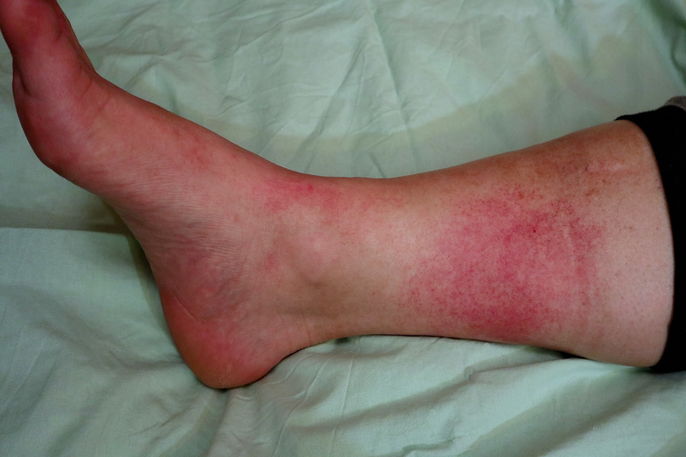Erysipelas is an infection of the superficial layer of the skin caused by Group A β-hemolytic Streptococcus bacteria that penetrate the skin through a wound or injury. Symptoms include fever, chills, and redness and blistering of the skin.
Erysipelas can affect the legs and is more common in people with venous insufficiency, obesity, and uncontrolled diabetes. It can also affect the arms and even the face due to a recent throat infection.
Erysipelas is treated by a dermatologist or primary care provider with the use of antibiotics taken by mouth to combat the infection. More serious cases may require hospitalization for treatment with IV antibiotics.

Main symptoms
The main symptoms of erysipelas are:
- Shiny red plaques on the skin with raised and well-defined borders;
- Swelling of the skin;
- Burning sensation;
- Localized itching and tenderness to the touch;
- Increased warmth in the area;
- General malaise, fever, and chills, typically during the 48 hours prior to the emergence of the red plaque.
It is important to consult a dermatologist as soon as possible after onset of symptoms to confirm a diagnosis and begin the appropriate treatment.
Is erysipelas itchy?
Yes, erysipelas is itchy. In fact, itchy skin is one of the most common symptoms of erysipelas, along with blistering of the skin and a burning sensation.
Confirming a diagnosis
The diagnosis of erysipelas is clinical and is made by a dermatologist or primary care provider based on an evaluation of symptoms, characteristics of the skin lesion, and a patient's medical history.
Blood tests like a complete blood count (CBC), erythrocyte sedimentation rate (ESR), and C-reactive protein may also be ordered, in addition to blood cultures to identify the bacteria causing the infection and guide treatment.
If blisters are present, a provider may also order a culture of the fluid inside the blisters to test for bacteria and identify the type.
What is the difference between erysipelas and cellulitis?
While erysipelas and cellulitis are both bacterial infections of the skin, erysipelas affects the superficial layer of the skin while cellulitis affects the deeper layers of the skin and the fatty tissue.
Erysipelas and cellulitis also differ in appearance. While erysipelas lesions are bright red with well-defined borders, cellulitis lesions are pinker in color and more diffuse without well-defined borders.
Possible causes
Erysipelas is an infection caused by Group A β-hemolytic Streptococcus bacteria that penetrate the skin through small wounds or injuries, such as insect bites, scratches, chilblains on the feet, or nail fungus.
Risk factors for erysipelas include:
- Chronic venous insufficiency;
- Vein stripping (or removal of the saphenous vein);
- Lymphatic obstruction;
- Uncontrolled diabetes;
- Overweight or obesity;
- Arteriovenous fistula;
- Nephrotic syndrome;
- Mastectomy.
People with a weakened immune system are also at increased risk for developing erysipelas.
Facial erysipelas is most often the result of a recent throat infection caused by Group A β-hemolytic Streptococcus bacteria, also known as Streptococcus pyrogenes.
Is erysipelas contagious?
No, erysipelas is not contagious. Erysipelas is caused by Group A β-hemolytic Streptococcus bacteria that normally live on the skin but can cause an infection if they penetrate the skin barrier through a break in the skin like a wound or injury.
Main types
The main types of erysipelas are:
1. Bullous erysipelas
Bullous erysipelas is a more severe type of erysipelas that causes darkening of the skin and blister formation.
2. Necrotizing erysipelas
Necrotizing erysipelas is characterized by the involvement of deeper layers of the skin, such as subcutaneous tissue, and can even cause destruction of the muscles.
This type of erysipelas needs to be treated as quickly as possible to prevent the bacteria from spreading to the rest of the body through the bloodstream and causing potentially life-threatening conditions like bacteremia or sepsis.
Treatment options
Erysipelas is treated by a dermatologist or primary care provider with the goal of eliminating the bacteria and relieving symptoms.
The main treatments for erysipelas include:
1. Antibiotics
Oral antibiotics (taken by mouth) are prescribed by a dermatologist or other provider to eliminate the bacteria causing the infection. First-line antibiotics for the treatment of erysipelas are penicillins or cephalosporins taken for 5 to 10 days.
People with a weakened immune system or skin necrosis, as well as children and older adults, may require hospitalization for treatment with antibiotics given through an IV.
2. Analgesics
Analgesics like acetaminophen may be recommended by a provider to help lower a fever.
3. Resting with feet elevated
Rest is essential in helping the immune system fight the bacteria causing the infection and allowing the body to recover. Elevating the feet helps reduce swelling in the legs.
A provider may also recommend drinking plenty of water and applying cold compresses to the area.
Can erysipelas be cured?
Yes, erysipelas can be cured by starting treatment as soon as possible following the onset of symptoms and completing the entire treatment course as prescribed by a dermatologist or primary care provider.
Appropriate treatment of erysipelas can also help prevent complications and reinfection.
Signs of improvement
Signs that erysipelas is improving include a reduction in swelling, pain, and redness of the skin, which may happen a few days after beginning treatment with antibiotics.
It is necessary to complete the entire course of treatment even if symptoms improve rapidly. This is in order to prevent antibiotic resistance that can prolong the course and make treatment more difficult.
Possible complications
Serious complications of erysipelas include abscesses, scarlet fever, meningitis, skin necrosis, thrombophlebitis, and hemorrhagic purpura, which are also caused by Group A β-hemolytic Streptococcus bacteria (strep A).
Another complication of erysipelas is bullous erysipelas, which is a more serious form of erysipelas affecting deeper layers of the skin.






























